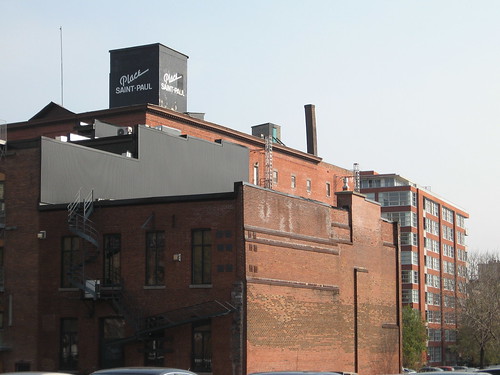Of the 864 census tracts in the Montreal Metropolitan Area, only three doubled their populations between 2001 and 2006. Two of the three cover areas in the Ville-Marie borough, as seen in the map below. Such rapid growth in population is in large part due to public-private programs designed to bring residents downtown, albeit with somewhat different outcomes in each tract. In this post I want to show a difference in how private-sector influence in urban development can affect changes taking place within a city.
The northwest tract covers the central business district, from rue Sherbrooke to rue St. Antoine, and from rue de Bleury to rue Peel. The southeast tract includes the Multimedia City, from rue Notre-Dame to rue de la Commune, and from rue McGill to rue de la Montagne. Between 2001 and 2006, the former’s population grew from 293 people 777 people, and the latter’s from 527 to 1146. Significant changes in only five years.

Renovated loft residences and new condos. Photo taken from rue St. Maurice and rue St. Henri in the southeast tract
Nearly half of the population in the southeast tract lives in housing constructed since 2001, much of which resulted from the public-private project Le nouveau Montréal. Le nouveau Montréal was a fairly new approach for Montreal, in that the municipality formed a partnership with private development companies and launched an advertisement campaign to promote living in the targeted areas. Many of the new residences are renovated loft spaces and new condominiums, drawing people with higher incomes. This has dramatically changed the composition of the tract’s population. In 1996, the median income was $15,285. In 2006, it was $40,715, one of the highest in the city. The percentage of those living below the low-income cut-off dropped from 28.1% to 5.7% during the same years, and the average gross rent increased 108%.
The northwest tract was not targeted by a specific public-private program such as Le nouveau Montréal, yet still grew in population due to government incentives to bring people into the inner-city; over 30% of its population lives in housing constructed since 2001. However, the composition of the tract’s population did not change as dramatically as in the northwest tract. In 1996, the median income was $10,485, rising to $17,428 in 2006. The percentage of those living below the low-income cut-off did not change from 16%, and the average gross rent increased 32%.
The city of Montreal is calling for the construction of 60,000 to 75,000 new residences in the city by 2014, according to its Habiter Montréal plan, 15% of which is to be public housing and another 15% as affordable housing produced by the private-sector.

3 comments
Wherabouts in town was the third sector to have such rapid growth?
Hello- sorry for not including that- a census tract in the Saint Laurent borough grew from a population of 3578 in 2001 to 7723 people in 2006. The borough mayor Alan DeSousa acknowledges the growth in the 2007 Mayor’s Report. A lot of new construction has attracted residents- over half live in housing constructed since 2001. With respect to the other stats- the percentage of people living below the low-income cut-off rose from 5.6% to 7.6% since 1996, and while median income grew from 32,787 to 46,734, rent more than doubled.
Thanks for satisfying my curiosity, I guess its not surprising that the third fastest growing area is still in the burbs; the only contender that came to my mind would be whichever census tract includes the Angus development in Rosemont
Je me demande pourquoi l’auteur ne traite pas de la zone à St-Laurent qui a grossi plus que les deux autres zones combinées… ah c’est la “banlieu” et c’est trop loin en bicyk. Dommage que ce blog soit si borné sur la plateau, même s’il dit, faussement, couvrir tout Montréal.